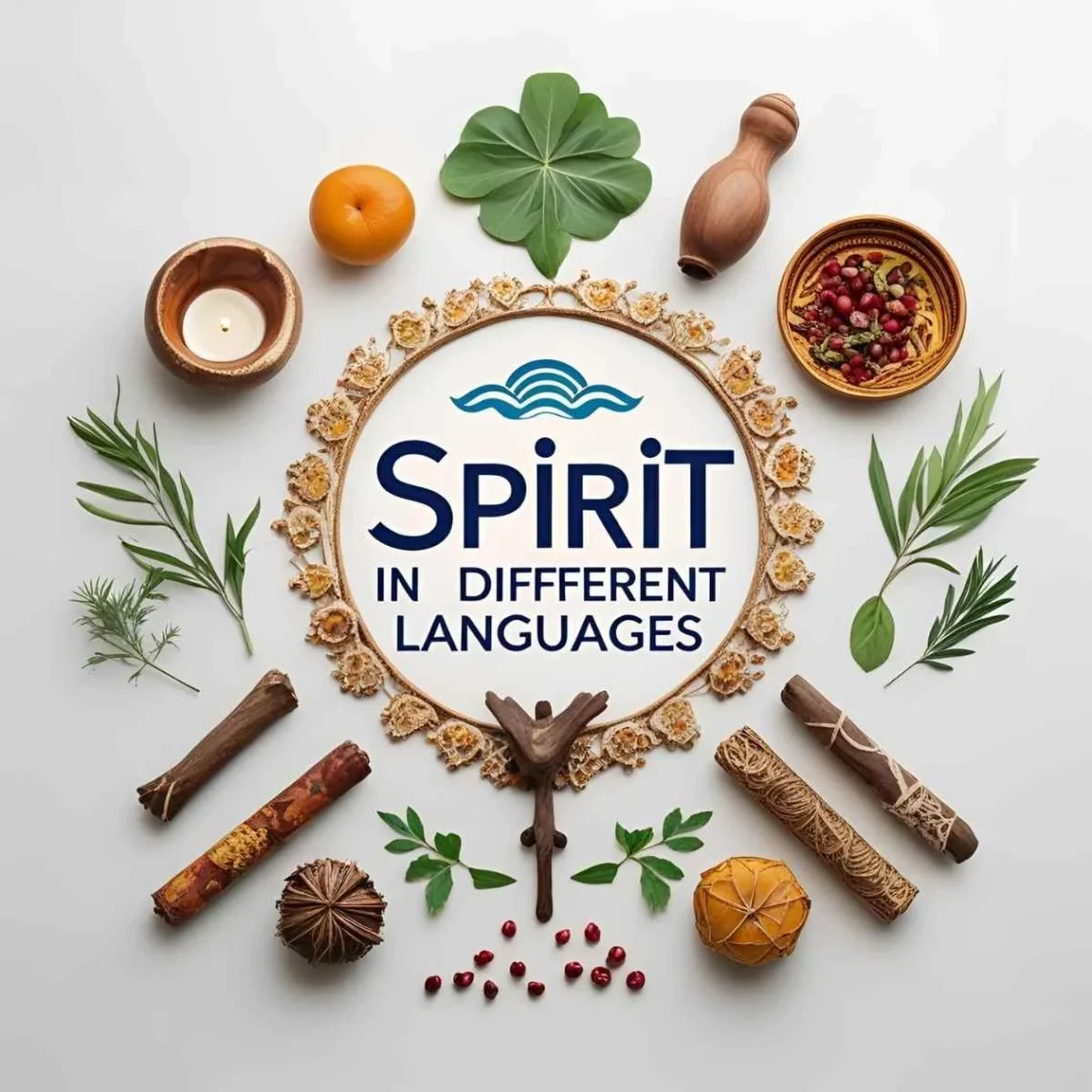Picture a quiet moment in a Kyoto temple, where a monk whispers “tamashii” to describe the essence of life. The word “spirit,” so simple yet profound, captures the invisible force that animates us all.
Whether it’s “espíritu” in a vibrant Mexican festival or “roho” in a Kenyan village, the term for “spirit” reflects a universal human quest to understand our inner essence, shaped by each culture’s unique beliefs.
Let’s embark on a global journey to explore how people express “spirit” in different languages and what these words reveal about their worldviews.
Reference Table: “Spirit” in Different Languages
| Language | Word/Phrase | Cultural/Linguistic Insight |
|---|---|---|
| French | Esprit | Refers to both mind and soul, used in philosophical and spiritual contexts. |
| Spanish | Espíritu | Tied to religious and cultural celebrations like Día de los Muertos. |
| Italian | Spirito | Evokes the soul or divine essence, often linked to Catholic traditions. |
| German | Geist | Means both “spirit” and “mind,” used in intellectual and spiritual discussions. |
| Mandarin | Línghún (灵魂) | Literally “soul-spirit,” tied to Taoist and ancestral beliefs. |
| Hindi | Aatma | Means “soul,” central to Hindu philosophy of reincarnation. |
| Japanese | Tamashii (魂) | Refers to the soul, deeply tied to Shinto and Buddhist beliefs. |
| Korean | Yeonghon (영혼) | Means “soul,” reflecting spiritual and emotional depth. |
| Arabic | Ruh (روح) | Means “soul” or “breath,” rooted in Islamic mysticism, used in 20+ countries. |
| Swahili | Roho | Means “soul” or “spirit,” tied to community and life force in East Africa. |
| Zulu | Umoya | Means “breath” or “spirit,” linked to ancestral worship in South Africa. |
| Yoruba | Èmí | Means “breath” or “life force,” central to Yoruba spirituality in Nigeria. |
| Maori | Wairua | Means “spirit” or “soul,” tied to nature and ancestry in New Zealand. |
| Hawaiian | ʻUhane | Refers to the soul, connected to the aloha spirit and island traditions. |
| Cherokee | Duyugodv | Means “truth” or “spirit,” reflecting inner essence in Native American culture. |
European Languages: Soul and Mind Intertwined
European languages express “spirit” with terms that blend soul, mind, and divine essence. For instance, in French, “esprit” refers to both the mind and the soul, used in philosophical debates and spiritual contexts, reflecting France’s intellectual heritage. Meanwhile, Spanish uses “espíritu,” prominent in cultural events like Día de los Muertos, where spirits of the departed are honored. Additionally, Italian’s “spirito” evokes the soul, often tied to Catholic rituals, as seen in prayers across Rome. In German, “Geist” encompasses both spirit and mind, used in everything from folklore to philosophical texts, showing Germany’s blend of mysticism and reason. Thus, these terms reflect Europe’s fusion of spirituality and intellectual thought, shaped by centuries of religion and philosophy.
Asian Languages: Spiritual Depths Across Cultures
Asia’s diverse languages offer profound terms for “spirit,” often tied to ancient philosophies. For example, in Mandarin, “línghún” (soul-spirit) reflects Taoist and Confucian beliefs about the soul’s connection to the universe, used in ancestral worship. In Hindi, “aatma” (soul) is central to Hindu teachings on reincarnation, spoken with reverence in India’s temples. Similarly, Japanese uses “tamashii” (soul), tied to Shinto and Buddhist views of life’s essence, often invoked in rituals. In Korean, “yeonghon” (soul) carries emotional and spiritual weight, used in heartfelt conversations. Finally, Arabic’s “ruh” (soul), used across over 20 countries like Egypt and Saudi Arabia, is rooted in Islamic mysticism, symbolizing divine breath. These terms highlight Asia’s spiritual richness, from philosophical depth to poetic reverence.
African Languages: Spirit as Life Force
In African languages, “spirit” often connects to community and the life force. For instance, Swahili, spoken in over 20 countries like Kenya and Tanzania, uses “roho” (soul), tied to the belief in a shared life force, often celebrated in communal rituals. In Zulu, “umoya” (breath or spirit) in South Africa links to ancestral worship, used in ceremonies to honor the departed. Similarly, Yoruba’s “èmí” (breath or life force) in Nigeria is central to spiritual practices, reflecting the soul’s eternal nature. These terms, spoken in vibrant markets or sacred gatherings, emphasize Africa’s view of spirit as a communal and vital force.
Indigenous & Island Languages: Spirit in Harmony with Nature
Indigenous and island languages express “spirit” with deep ties to nature and ancestry. For example, Maori in New Zealand uses “wairua” (spirit), reflecting a connection to land and ancestors, often invoked in ceremonies. In Hawaiian, “ʻuhane” (soul) embodies the aloha spirit, used in blessings and storytelling. Similarly, Cherokee’s “duyugodv” (truth or spirit) signifies inner essence, used in Native American rituals to honor life’s core. In Samoan, “agaga” (spirit) reflects the Pacific’s communal values, often tied to family and tradition. Across these cultures, from New Zealand to the Cherokee Nation, “spirit” emphasizes harmony with nature and community, celebrated through rituals and stories.
Cultural Insights: The Evolution of the Soul’s Language
Words for “spirit” have evolved with cultural and spiritual shifts. For instance, the Latin “spiritus” (breath, circa 1st century BCE) influenced European terms like “esprit” and “espíritu,” tying spirit to life’s breath. In Arabic, “ruh” traces back to early Islamic texts, symbolizing divine creation. Moreover, in African traditions, terms like “roho” and “èmí” reflect ancient beliefs in ancestral spirits, shaping modern rituals. In Asia, “aatma” and “tamashii” align with philosophies of reincarnation and cosmic unity, rooted in millennia-old texts. These words carry histories of religion, philosophy, and cultural exchange, uniting humanity’s quest to define the soul.
Proverbs and Sayings: Wisdom of the Spirit
- French: “L’esprit souffle où il veut.” (The spirit blows where it wills.) – Reflects the soul’s freedom.
- Hindi: “Aatma amar hai.” (The soul is immortal.) – Emphasizes eternal life in Hindu belief.
- Swahili: “Roho ni kama upepo, haionekani.” (The spirit is like the wind, unseen.) – Highlights its intangible nature.
- Japanese: “Tamashii wa kokoro no kagami.” (The soul is the mirror of the heart.) – Ties spirit to emotion.
- Yoruba: “Èmí ni ohun ti o mu ayọ.” (The spirit brings joy.) – Links spirit to fulfillment.
FAQs
Why do some words for “spirit” sound similar?
Shared linguistic roots (e.g., Latin “spiritus” in European languages) and cultural exchanges (e.g., Arabic “ruh” in Swahili) create similarities.
What’s the oldest term for “spirit”?
Latin “spiritus” (circa 1st century BCE) is among the earliest, influencing many modern European terms.
How do cultures shape the term’s use?
Collectivist cultures (e.g., African, Indigenous) view “spirit” as a communal force, while individualistic cultures (e.g., European) emphasize personal essence.
Conclusion
From “espíritu” in Spain to “roho” in Tanzania, the word for “spirit” weaves a universal thread through humanity’s soul. Each term, whether the philosophical “línghún” in Mandarin or the communal “wairua” in Maori, reflects cultural beliefs while celebrating our shared quest for meaning. Consequently, these words remind us that the spirit transcends borders, uniting all Eli all people in a nod to the soul. How do you say “spirit” in your language, and what does it mean to you? Share your thoughts below—we’re eager to hear your story!





